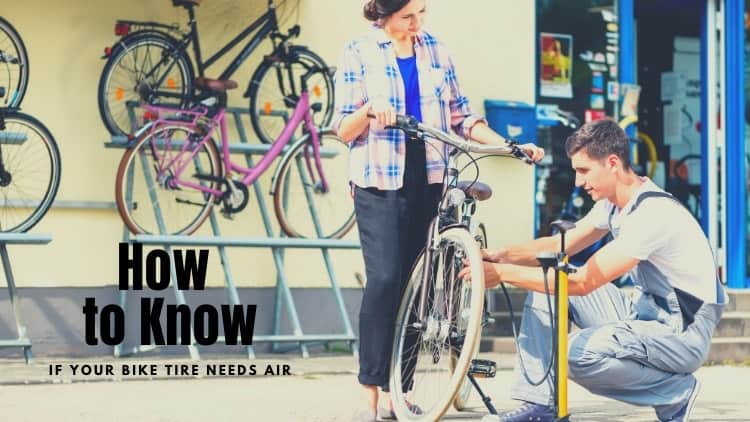When it comes to Biking, a lot of riders will tell you just how important your tire pressure is.
Whether you are running tubes or tubeless, air pressure is something you must always regulate.
Unfortunately, getting the right tire pressure can be a challenge for most new riders. This is even something that affects experienced cyclists.
For fear of under-inflation, a lot of riders will find themselves riding around on over-inflated tires.
Even worse, it can be hard to tell if your bike tires need more air.
In this article, we help you recognize some of the symptoms of low tire pressure, along with ways you can better maintain your bike tire pressure.
You know your bike tires need air if you can feel your rim hit whenever you go over obstacles, if your bike feels spongey or delayed in response if you feel unsteady during turns, or if you see a considerable amount of tire sag once you sit on the bike. In this article, we help you notice the signs of low bike tire pressure, along with a few tips to help you add the correct tire pressure.
As I mentioned earlier, there are a few telltale signs that you have low tire pressure.
To help you better recognize these signs and prevent them, we will further explain what to look for and how to fix it.
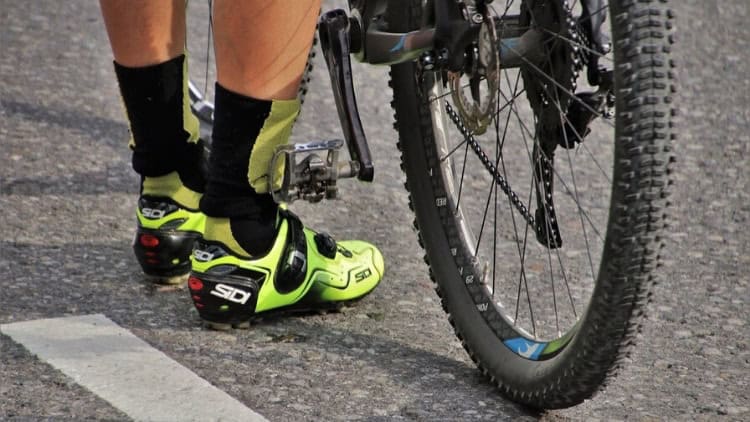
Signs your Bike Tire Pressure is Too Low
Not having enough air in your bike tire can be frustrating.
On top of that, running too low of tire pressure can be dangerous and possibly damaging to you or your bike.
Running the correct tire pressure will not only keep you safe, it will help you get the most out of your bike.
Your tire needs to be able to conform just enough to maintain grip but should also be stiff enough to handle obstacles without hitting the rim.
Finding a balance can be tough in the beginning, but there are a few ways you can tell if your bike tire needs more air.
If you can feel the rim hitting obstacles
Whether you ride a Road Bike or a Mountain Bike, your bike tires are meant to be stiff enough to absorb the blow from most obstacles.
Since most of your weight is held towards the back of your bike, it is especially important to have enough air pressure in the rear bike tire.
If your tire does not have enough tire pressure, the tire will bottom out, making the obstacle strike your actual rim.
Rims are not meant to handle the blows and strikes that a bike tire does.
In fact, you can easily damage your rims, making it impossible to properly seal.
If tires feel wobbly or unsteady while turning
As I mentioned before, the rear bike tire will handle most of your body weight.
This is especially true when you are turning at a fast rate of speed.
As you start to put more stress on that rear tire, it will want to fold over and conform to the ground.
If your bike tire pressure is low, your tire will lose its shape and start to fold over, making you feel unsteady.
If your bike handles feel spongy or lagging in response
In order to have traction, your bike tires conform to keep as much surface area in contact with the ground.
While this comes down to making sure you do not have too much air pressure, there is also an issue with running too low of tire pressure.
With too low of bike tire pressure, your tire conforms too much. This gives you more traction but also results in more friction.
This will make it harder for you to get your bike moving, making pedaling more laborious.
On top of that, you lose the bounce and responsiveness that comes with properly inflated tires.
It will take more of your energy to turn the bike and maneuver it how you need to.
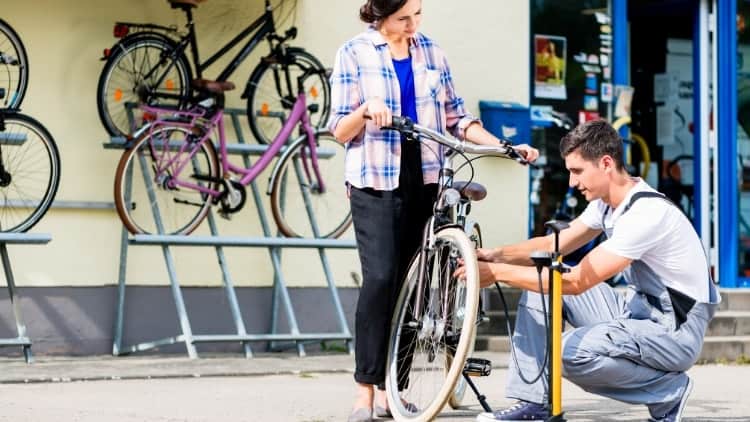
Ways to Check Air in the Bike Tires
If you notice any of the symptoms mentioned above or are suspicious that your bike tires need air, you should always give them a check before riding.
Luckily, the ways to check your bike tires are relatively inexpensive and easy.
If you have a tire pressure gauge and a tire pump, you should have no problem getting the right PSI added to your tires.
One of the best things to have is a pump and gauge combo like the Bell Airstrike 850. This is a great pump because it is small and works on both Schrader and Presta valves.
If you are without a tire pressure gauge, you may have to get a little creative.
With a Tire Pressure Gauge
As I said, checking tire pressure with a gauge is really easy and therefore, I recommend it.
Check and match the recommended PSI on the side of the tire – If you have a tire pressure gauge, you can use it to check your tire pressure against the recommended PSI engraved on the tire sidewalls. Use a tire pump to add and remove air, until you get the correct PSI.
Check and match recommended PSI for your weight – You can also use a guide like this one from Bicycling.com to see what the recommended PSI is for your weight. Once you find a suitable range of pressures, use a tire pump to match the air in your tire to the pressure recommended by the guide.
Without a Tire Pressure Gauge
If you do not have a tire pressure gauge, it’s going to be hard to get the exact PSI you need, however, you are not out of the fight yet.
If you have a little patience and a good feel for your bike, you can probably get really close to the correct tire pressure.
Test by Feel – Although it’s not an exact science, you can actually judge your bike tire pressure by the way your bike feels. In fact, when I am out on the trail without a tire gauge, I often adjust my tire pressure based on the feel of the bike. If your bike feels sluggish and you keep banging the rim, you definitely need to add air. On the flip side, if you are bike feels too bouncy or jittery and you lose traction, you will need to let some air out of those tires.
Thumb Check – An age-old trick handed down from generation to generation is the ole “Thumb Check”. This involves filling the bike tire with air and then pinching the tire just above the rim to feel how tight it is. This is not too reliable and usually follows up a visual sag check, however, it’s been around this long for a reason.
Puddle Trick – Experimental* – Although I have not personally tried this, some riders have recommended the “Puddle Test”. This involves riding through a puddle to see how high the water comes up on the tire walls. If it is too high, it means your tires do not have enough air in them. I am a little suspicious of the physics of this one, so let me know if you have any luck.
Regardless of how creative you are, it can be a pain to check your tire pressure without a gauge.
To save you the trouble of having a gauge and a pump, or not having one at all, you can actually get a bike tire gauge and pump combo.
I recommend the Bell Airstrike 850, not only is this a low-profile pump, it also fits Schrader and Presta valve tires.
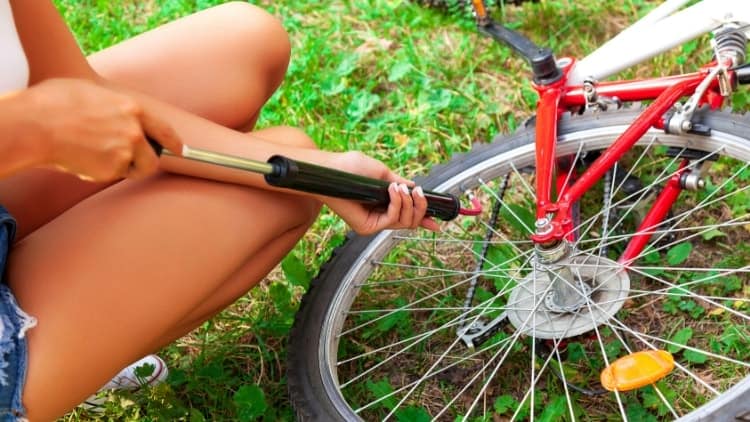
How Often Should You Check Bike Tire Pressure?
Depending on how often you ride and what you ride on, there are certain intervals where you should check your bike tire pressure.
Unless you experience any issues, you should only have to check your bike tire pressure about once per week.
Depending on how you review your rides, you may even want to check your tire pressure before each ride.
How Often Should You Have to Air Up a Bike Tire?
Although bike tires and tubes have come a long way, they still experience the occasional leak.
In fact, a standard bike tire will lose a few PSI per week.
And chances are, if you feel like you are always putting air in your tires, you are probably just experiencing the normal leaking interval most tubes have.
To help you decide if this is your case, here is a rough estimate of how often you should add air to your bike tires.
Road Bike – Road Bike tires are a lot skinner and hold a higher PSI than you would see in most Mountain Bikes and Hybrids. Since Road Bike tires need near-perfect tire pressure to perform properly, you should try to air up your Road Bike tires 1-2 times per week.
Mountain Bikes and Hybrids – Mountain Bikes and Hybrids are a little more forgiving when it comes to the acceptable range of tire pressures. Regardless, running the correct tire pressure ensures safety and performance out on the trail, so you should still try to air them up at least once per week.
What Happens if I Add Too Much Air?
Bike tires are meant to operate at the recommended PSI engraved on the sidewalls and for the recommended weight of the rider.
Again, this is something that affects safety and performance.
Most riders will err on the side of over-inflation when it comes to tire pressure, which is just as dangerous as under-inflation.
If you add too much air to your bike tires, they will not have as much traction and will be more prone to leak or burst.
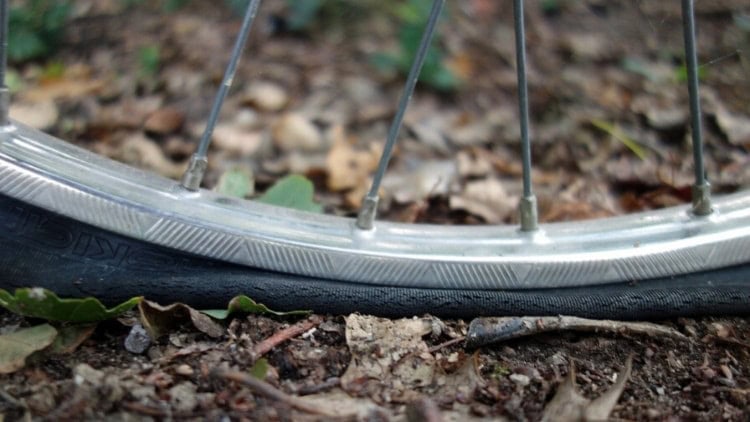
What Happens if You Keep Riding with Low Tire Pressure?
Although you are less likely to under-inflate your tires compared to adding too much air, it is still common.
Where over-inflated tires lose their performance, under-inflated tires can fail altogether.
Not only will it be harder to maintain speed, you will not be able to ride as aggressively as you would like.
Conclusion
In conclusion, having the correct air pressure in your Bike tires is really important.
There are many ways to tell if your tires need more air and it is really easy to get the correct tire pressure.
Good luck getting your tires aired up and safe riding!

